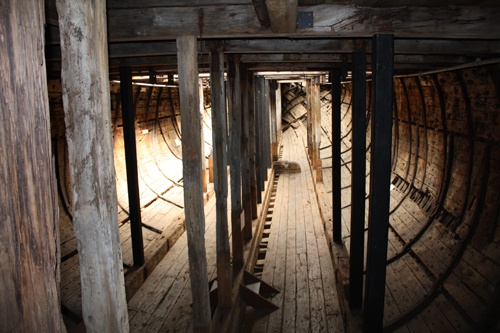
Edwin Fox, Picton (1873)
Migrant ship and pioneer freezing hulk
Only two of the ships that brought British settlers here in the 19th century survive. San Diego has preserved Shaw Savill & Albion’s Euterpe (1863) immaculately as the Star of India. Picton has the battered hulk of the same line’s Edwin Fox. Tatty she may be, but the Edwin Fox has seen a lot of history since entering the water at Sulkeah on the River Hooghly in India in 1853. She is an ‘East Indiaman’ and when new was 747 tons gross, 44.14 m long and carried square sails on all three masts. The stubby old-fashioned design resembled that of the Blackwall frigates that were gradually replaced by sleeker clipper ships. But as you can see at Picton today, there was nothing wrong with the worm-resistant Burmese teak that went into her hull. The Edwin Fox carried troops to the Crimean War and transported convicts to Australia – she is the only surviving Australian convict ship.
The ship’s New Zealand connection began in 1873 when Shaw Savill & Co. bought her to carry migrants, 100,000 of whom were assisted to migrate here during that decade. Described as almost a museum piece ‘and nothing but trouble’, the Edwin Fox nevertheless made several uneventful voyages to New Zealand. Although she was too tubby to be fast, her spacious and comfortable accommodation appealed to passengers. In 1883 the newly merged Shaw Savill & Albion Co. decided to convert her into a floating freezer storage hulk. The work, completed at Port Chalmers two years later, included cutting down the masts and fitting massive boilers on the upper deck to power the refrigeration plant. The Edwin Fox’s sailing days were over.
For the next 12 years the old ship served wherever extra freezer storage capacity was needed. In 1897 a steamer towed her to Picton, where her freezing machinery went into the new freezing works. The ship became an accommodation hulk and then for more than four decades from 1905, a coal hulk and mooring facility. Fortunately interest in the Edwin Fox was not confined to the vandals who stripped her teak. In 1967 the Edwin Fox Restoration Society pumped out the hull – ripped brutally from the mud's embrace with gelignite! – and discovered that it was surprisingly sound below the waterline. But that was as far as they got, for politicians did not want the old hulk near their gleaming new ferry terminal.
The Edwin Fox lay beached in Shakespeare Bay until northern plans to snatch the ship revived local energy. In late 1986 she was floated free and towed to a new berth near the ferry terminal. Thirteen years later the Edwin Fox, once the lowliest of hulks, entered her own new graving dock where workers scraped 4 tonnes of mussels from a hull that had not been dry-docked for over a century. In 2000 the former Historic Places Trust gave she ship its highest Category I registration. Unrealistic dreams of ‘restoration’ have been replaced by more sensible plans to preserve it as a hulk beneath a roofed enclosure, which was opened in December 2001. The Edwin Fox is now a major tourist attraction.
Further information
This site is item number 45 on the History of New Zealand in 100 Places list.
On the ground
The museum complex is staffed and includes an audio-visual presentation and museum galleries featuring artefacts from the ship and the people associated with her.
Websites
Book
- Henry Brett, White wings, 2 vols, Brett Publishing Co., Auckland, 1924 and 1928









Community contributions